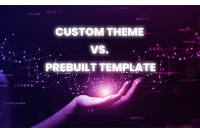
Article
E-Commerce is clapping across the world, and no doubt everyone is making the presence felt from small brick and mortar stores to big giants! What makes you outshine your competitors is how you make your customer navigate the store during their purchase journey. Deciding the right fit for your business, an e-commerce platform is not the only success to get ROI, but the theme has the identical weight. The theme represents the brand and connects it to the visitors who later become your customers. Have you ever had a thought on how selecting the suitable theme will influence your store’s ROI?
This article is all narrated on picking up the best website builder for online stores that aids you in choosing the suitable theme. What is the difference between going with a prebuilt theme versus custom themes? Let’s dive deeper.
Table of Contents
What is an e-commerce theme?
Irrespective of the platform you are willing to set your online store, the theme is a predefined structure that represents the storefront. E-commerce platform like Magento & Shopify provides the basic template on which the native functionalities work, which sets them apart from others. For instance, Shopify has a different checkout page layout than Magento. Essentially, the frontend theme — is the look and feel of your website. It dictates the visual frontend elements like the structure of your home page, the colors pallets of the brand, the font styles used in the content page, etc. The theme also controls how responsive or mobile-friendly your site is.
The question you may have in mind is why we are discussing theme and web design where there are more custom features and advancements in the market. The reason is to draw merchants’ and online retailers’ attention over choosing the suitable theme that depicts the brand. It only takes 0.05 seconds for users to create an opinion about the store. If your site is not clean, not responsive, unable to navigate the right path, buddy, you made a wrong turn!
What is the method to build the theme?
So, When a client plans to build the store, the instant question we ask the client is, are you willing to go with a template or a custom-built one? Why does this question have significance? Why do we keep asking? Here’s the answer. In general, the storefront can be defined in three ways, and it also represents the brand and impact site usability:
Each of these three methods has a distinct process and good and bad. Choosing one of the above methods will define your store optimization, time to build the site and go live, and utilization of efforts. Rolling ahead to see how does it count.
Go with the Native Theme
Native themes are the prepackaged component that helps present your e-commerce store. Native themes combine technology stacks that an e-commerce platform has used as a frontend build and media files that customers see on the front.
This native template has an easy-to-install and builds functionality for first-time business owners seeking to take the first move. Online retailers can make cosmetic changes based on brand identity and add some CMS pages using such a theme.
Benefits of using Native Theme
- Effortless to move: No additional efforts are required to build the pages. Manage your content and branding to start the process. Editing can initially be a learning stage if you are a first-time user, but my friend, you can have plenty of tutoring videos available in the market as resources.
- Affordable: When we go native, no additional costs are involved in development. If you use any subscription-based e-commerce platform, you will pay the only fee. Rest depends on the other platform, but I am sure it won’t lose your pockets more.
- Quick to market: With the plug-and-play kind of page builder facility that e-commerce platforms provide, it is easy for merchants to go live and play around with the page sections. Only a bit of knowledge to manage, and here you go!
Drawbacks
- Generic: Any of the e-commerce platforms, whether it is Magento, Shopify, or any other, have built the theme following broad application. Using the native template is fine, but other stores seem generic. Nowadays, brands are leaning towards personalization, and hence being Generic is a BIG NO.
- Limited Functionality: Native themes come with the primary customer journey and purchase flow. There’s no such advancement one can have using Native. You must ask the solution providers to help you with scalability and complex functions.
Third-party templates
There are ample ready templates available to adopt and go live quickly. Not only do e-commerce platforms provide such templates, but there are N numbers of marketplaces known to get the templates. Online retailers can find the industry-specific theme and customize it based on the brand look and feel. Such templates are used when merchants have a small budget and time to tweak the theme and go live! With quick achievements, there are concerns about using such templates. Let’s figure it out!
The usefulness of using Third-party themes
- Low Expense: As the majority of the themes fall under $0 to $250, it costs lesser than having a custom theme development.
- Already Tested: The themes are tried and tested by the solution providers. The theme is being tested on multiple browsers and devices. On top, you can make specific cosmetic changes quickly.
- Industry Specific: Theme is available based on industries like Food & Travel, Fashion, Footwear, Jewelry, etc. Merchants can choose the layout by having a reference that store demos provide.
Disadvantages:
- Hard to customize: The theme often comes with a “GENERAL” code that specifies the particular industry. Hence, even having quick changes takes time and is complex. It may conflict with the other elements of the stores.
- No future updates and Support: Once you amend the theme with several pages, you lose the theme providers’ Support. It also makes it more difficult for engineers when there is an update on Platform upgrade and building custom features.
- Lower page Speed: Merchants choose the templates but hardly utilize them in most cases. For instance, mainly the templates are used for the Home page, and the rest of the Code becomes unutilized! The store’s back end is filled up with unused Code that results in unnecessarily long loading times.
- More Support and maintenance: Buying themes ad amending them as per the brand, lately, put merchants to invest more. With the latest updates or installing other extensions, the theme may conflict, and by resolving it, merchants end up with extra expenses than the theme’s custom build.
Let’s focus on Custom Themes.
Custom Theme Development
The most preferable and standard way to have your store is to set up a custom storefront. The custom theme allows you to craft the store, focusing on your customer and brand. This method puts more weight on clean Code, the best possible user experience, and is unique from other stores. All the drawbacks from prebuilt themes got resolved by a custom one. See what they are!
Benefits:
- Neat and clean Code: The design is purely based on your brand and audiences; the Code is pretty clean and has possibly the best customer experience throughout the purchase path. This means zero unutilized codes that hinder the site speed and adding extra features won’t slow down. Going custom is the key to success!
- Unique Design: Crafting a store using a custom theme will allow merchants to have designs that outperform the competitors. Unique design loudly represents who you are. Brainstorming and requirement discovery is vital before setting up the visuals that add value. Around 50% of internet users say that website design is crucial in formulating an opinion about a brand.
- Functionality: Everything becomes easy when you have a custom-built store. Once you are ready with the custom store, it will be easy for developers to extend the features and functionality with the themes and not to have conflicts while developing it.
Drawbacks
- Cost: The major drawback of building custom templates is cost. To visualize and create a custom theme, merchants need a team of a designer, a Frontend developer, and a tester to work together. It requires more team effort than the ready templates and ultimately becomes costly. But looking at the significant benefits in the longer run, merchants can always compensate with ROI.
- Time: The other drawback for the custom theme is time. It requires a reasonable amount of time for designers to understand the client’s view and build the design following the best user experience. The design will take almost 5-6 business weeks.
Yes, Even time and money are a concern for first-time merchants who are willing to have their e-commerce store quickly up and running, but those already in the market can surely invest in custom themes to outperform.
Conclusion
Choosing the right fit depends on what merchants want their store to become? If you are willing to get good ROI and impressive footfall, make sure your store stands alone in the market. There are three touch points to note Time, Cost, and Extended functionality. Investing in all three theme touchpoints will lead you to profitable returns. Ensure your store must be optimized with smooth checkouts and order processing with fast page loads. Points like this will allow your visitors to become your customers and allow customers to come back to your store. ????
Want to know which path to choose? Let’s connect with experts!

